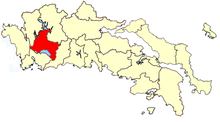
The Hellenic Coast Guard is the national coast guard of Greece. Like many other coast guards, it is a paramilitary organization that can support the Hellenic Navy in wartime, but resides under separate civilian control in times of peace. It was founded in 1919 by an Act of Parliament and the legal framework for its function was reformed in 1927. The current name is specified in Law 3022/2011.
Dasylio is a neighbourhood in the city of Patras, Achaea, Greece.
Amygdalea is a village in the Elimeia municipal unit, Kozani regional unit, Greece. It is situated at an altitude of 365 meters. The postal code is 50100, and the telephone code is +30 24610. The population was 66 at the 2011 census.
RBU is a time code radio station located in Moscow. It transmits a continuous 10 kW time code on 66⅔ kHz. This is commonly written as 66.66 or 66.666 kHz, but is actually 200/3 = 66.6̅ kHz. Until 2008, the transmitter site was near Kupavna 55°44′04″N38°9′0″E and used as antenna three T-antennas spun between three 150 metres tall grounded masts. In 2008, it has been transferred to the Taldom transmitter at 56°44′00″N37°39′48″E.
Polichne, or Polichna (Πολίχνα), was a town of ancient Ionia, near Clazomenae. After the losses of the Athenians in Sicily, Clazomenae revolted with Chios and Erythrae against their Athenian overlords. The Clazomenii at the same time began to fortify Polichne on the main as a place of refuge, if it should be necessary. The Athenians took Polichne, and removed the people back to Clazomenae, except those who had been most active in the revolt; and they went off to a place called Daphnus.
Polichna was a town of ancient Ionia, near Erythrae.
Lysimachia or Lysimachea or Lysimacheia (Λυσιμάχεια) was a small town in ancient Mysia, mentioned only by Pliny the Elder, in whose time it no longer existed.
Apollonis , also known as Apollonia (Ἀπολλωνία), Apollones (Ἀπολλώνης), and Apollonias (Ἀπολλωνίας), was a city in ancient Lydia. It was located south of Apollonia in Mysia, where there is a ridge of hills, after crossing which the road to Sardis had on the left Thyatira, and on the right Apollonis, which was 300 stadia from Pergamum, and the same distance from Sardis. It was named after the queen Apollonis, the mother of Eumenes II and Attalus II of Pergamum, in the place of an older city; possibly Doidye. It was mentioned by Cicero. It was destroyed in 17 CE by the great earthquake that destroyed twelve cities of Asia Minor. Tiberius rebuilt the city. It issued coins; those from Marcus Aurelius to Severus Alexander are extant. Apollonis is a titular see of the Roman Catholic Church.
Heraclea or Herakleia (Ἡράκλεια), also transliterated as Heracleia, was a town of ancient Lydia at the foot of Mount Sipylus. From this town magnets were known as Heracleus lapis.
Hypokremnos was a town of ancient Ionia.
Helos was a town of ancient Ionia, near Erythrae.
Cybeleia or Kybeleia or Cybellia was a city of ancient Ionia. Strabo, after saying that the mountain Mimas is between Erythrae and the Hypocremnus, adds, "then a village Cybellia, and the promontory Melaena." This is all that is known.
Embatum or Embaton was a town of ancient Ionia, in the territory of Erythrae, mentioned by Theopompus in the eighth book of his Hellenica. It appears from Thucydides that it was on the coast.
Gerriadai was a town of ancient Ionia, near Teos.
Kyllene, also known as Ascanius Portus, was a port town of ancient Aeolis.
Achaion Limen was a port town of ancient Aeolis.
Atarneus, called Atarneus sub Pitanem to distinguish it from the other city of the name, was a town of ancient Aeolis near Pitane.
Agatheira was a town of ancient Lydia, inhabited during Hellenistic times. Its site is located near Halitpaşa in Asiatic Turkey. This colony was called a katoikiai, along with Magnesia-by-Sipylus, Hyrcanis, and Thyateira. They were separated from one another by about fifteen kilometers.
Kaira was a town of ancient Lydia. Its name does not occur among ancient authors, but is inferred from epigraphic and other evidence.
Salarama was a town of ancient Lycaonia, inhabited in Roman and Byzantine times.

